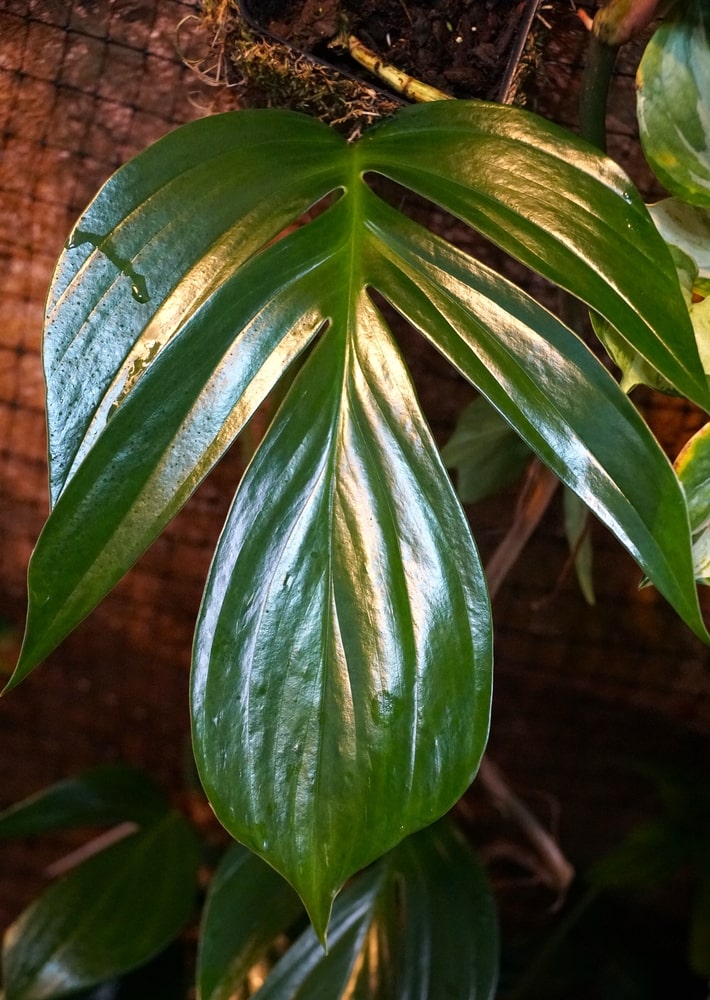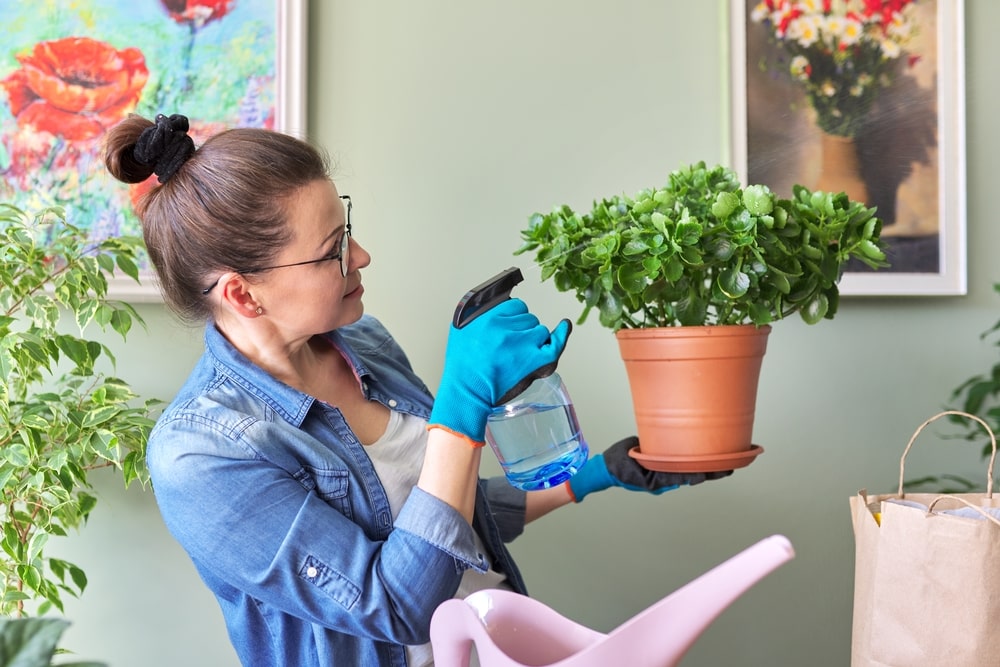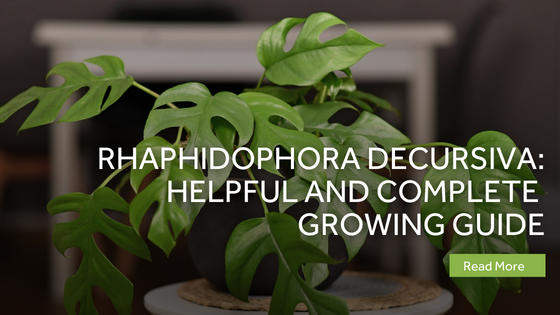If you are looking for a beautiful climber with vibrant, glossy green leaves, the Rhaphidophora decursiva may be the one for you! This rapidly growing plant will leave a lasting impression on your indoor or outdoor space with its foliage and coloring. This terrestrial tropical plant is easy to care for and long-lasting, making it perfect for a novice or expert plant caretaker.
Table of Contents
Rhaphidophora Decursiva Overview
The Rhaphidophora decursiva is a tropical aroid plant that originates in the world’s tropical regions, including Southeast China, Asia, and India. The Rhaphidophora decursiva hails from the family Araceae and, in the wild, is known as an epiphyte. This means the plant is a tree lover, growing on the trees’ trunks, allowing it to reach massive heights in nature.
Rhaphidophora decursiva has a few nicknames, such as “Dragon’s Tail” or “Monstera decursiva.” Dragon’s tail refers to the leaf shape, and Monstera decursiva due to its similar appearance to Monstera plant, even when the two are not in the same genus.
Other notable relatives of the Rhaphidophora decursiva include the Rhaphidophora Cryptantha, Rhaphidophora tetrasperma, and Rhaphidophora korthalsii.
Rhaphidophora cryptantha: This species in the Rhaphidophora genus, also called the shingle plant, is known for dark green leaves with striking silver veins.
Rhaphidophora tetrasperma: The tetrasperma plant of the Rhaphidophora genus is another climbing plant with green lobed leaves, similar to the Monstera plant.
Rhaphidophora korthalsii: Rhaphidophora korthalsii is a climber similar to its relatives listed here but has smaller, rounder leaves of dark green.
| Botanical Name | Rhaphidophora decursiva |
| Family | Araceae |
| Genus | Rhaphidophora |
| Origin | Southeast China, India, Asia |
| Sunlight | Bright indirect light |
| Watering | Once the top 2 inches of the soil has dried |
| Soil | Aerated and well-draining soil |
| Temperature | 65-80 degrees Fahrenheit |
| Propagation | Stem cuttings, air layering |
| Re-Potting | Every 1-2 years, depending on growth, when rootbound |
| Pests and Diseases | Spider mites, mealy bugs, bacterial/fungal rhizome disease |
| Toxicity | Toxic to humans and pets |

Rhaphidophora Decursiva Plant Features
The Rhaphidophora decursiva is a climbing plant in Araceae, also known as the aroid family. These plants can demonstrate huge growth rapidly and have beautiful features. In the wild, Rhaphidophora decursiva plants can grow up to 50 feet in height as the plant matures. This is because of their aerial roots, which attach to other trees.
If you use this plant in your home or outdoor space with a trellis or other support, you will not see this growth. Typically, the Rhaphidophora decursiva will grow to heights averaging around 5 feet long. When mature, the leaves can grow to around 40 inches long and up to 20 inches wide.
The foliage of this species can look very different before and after maturity. When the Rhaphidophora decursiva is young, it is often mistaken for a philodendron plant due to its small, oval, and pointed leaves. As it reaches maturity, the leaves will develop lobes around the edges, which creep slowly toward the center, separating the leaves into fringe shapes.
Aside from the unique shapes of the leaves, the Rhaphidophora decursiva is known for its magnificent green coloring and makes a wonderful tropical backdrop for any space. Rhaphidophora decursiva plants often flower in the wild, but this event is far rarer in these plants when indoors. When keeping the plant indoors, note that the Rhaphidophora decursiva is toxic to humans and pets.
Rhaphidophora Decursiva Care Guide
The Rhaphidophora decursiva is a terrestrial tropical plant from warm and moist climates. This species thrives in an environment that meets the lighting, watering, soil, temperature, and humidity requirements similar to where it originates in the tropical regions of Southeast China, India, and Asia.
Ideal Growing Place
This plant can be placed in a pot with well-draining, aerated soil, indoors or outdoors, if the climate is appropriate. Rhaphidophora decursivas prefer warmer temperatures, moderate watering, and high humidity.
The growing season for Rhaphidophora decursiva is during the warmer spring and summer months, while growth declines in the colder fall and winter months. During the growing season, your plant will require more water, a few extra nutrients, and less during the dormancy period.
Water
The best way to ensure you properly water your Rhaphidophora decursiva plant is to check the top 2 inches of the soil. If you place two fingers into the soil and pull out loose pieces, it is time to water! The Rhaphidophora decursiva should be planted in well-draining soil to not hold too much water, which can lead to many problems with the leaves or even root rot.
In the growing season of spring and summer, you may need to water your plant once a week to support its new growth. In the fall and winter dormancy periods, you may need to water once every two weeks.
Sunlight
The Rhaphidophora decursiva plant is known for its stunning leaves. However, too much sunlight can harm your foliage, so placing this species in bright indirect light is best. If you use this species as a houseplant, a south-facing window or north-facing window can offer this ideal light. Before planting outdoors, consider the potential location of your Rhaphidophora decursiva and the lighting found there.
Temperature
This tropical climber prefers temperatures of 65-80 degrees Fahrenheit to grow successfully. This is a great range for those looking to plant their Rhaphidophora decursiva indoors or in a greenhouse. If you are planting outdoors, keep an eye on temperatures throughout the year, and bring indoors when out of range.
Soil
A well-drained medium is ideal for the aerial roots found with the Rhaphidophora decursiva. Plants in the aroid family require space in the soil for roots to grow and absorb moisture and oxygen without too much water being held. Additions to potting soil that can help aerate include peat moss, vermiculite, and orchid bark. Make sure to place your plant in a pot that has drainage holes as another way to encourage water drainage.
Humidity
Rhaphidophora decursiva is a tropical plant that thrives off high humidity levels around 60% or higher. The decursiva can also adapt to lower humidity if you are planting indoors. To meet the high humidity level preference, consider using misting methods or a humidifier to give your plant extra moisture in the air.
Fertilizer
It needs a nutritional boost during the spring and summer months when the Rhaphidophora decursiva grows its foliage and roots. Give your decursiva a liquid fertilizer about once a month to support this growth. The fall and winter months slow your plant’s growth with dormancy, so you need only provide your plant fertilizer every two months.

Pinching/Pruning
Unless any leaves show signs of yellowing, this plant does not often need pruning until it grows too large after many years. If you need to remove any leaves, grab gloves and sterilized shears or a shape knife and cut off the leaf at the base.
Potting and Re-potting
Your Rhaphidophora decursiva will often show you signs to let you know it is time to repot. The most notable will be if you see roots pushing out of the drainage holes in your pot. This means they have run out of space and need more room. Other signs include new leaves that are small and excessive water intake.
It can also be beneficial to repot your plant yearly in the spring to offer your Rhaphidophora plant fresh soil and nutrients. This can further support your plant’s new growth to come.
Growth Zone
Rhaphidophora decursivas can grow outdoors successfully in the 9a-11 ranges of the USDA Plant Hardiness Zone Map. These areas of the United States encompass the southern states in addition to the west coast.
Common Pests, Toxins, Diseases & Other Problems
Common pests affecting your decursiva plant include spider mites and mealy bugs. These insects can easily be taken care of with a plant oil spray and continued cleaning of the large leaves by wiping them down gently.
Bacterial or fungal rhizome diseases are also noted with Araceae members. Leaf spots on the plant can note these diseases. You can check your plant’s root system for rotted or brown spotted rhizomes and remove them carefully.
It is also important to note that the Rhaphidophora decursiva is toxic to humans and pets due to oxalate crystals in the plant. Handle carefully when cutting the plant for pruning or propagation, and keep away from pets and children.
Propagation
There are two methods you can use to propagate your Rhaphidophora decursiva. The first method is stem cutting. To do this, find a stem area with 1-2 nodes and a leaf. Make sure you use gloves and a sterilized tool to make your cut. Once you have the cutting, you can place it in water, replacing it often to keep it fresh. You can also place the cutting in moist soil, misting often.
The second method is called air layering propagation. To do this:
- Find aerial roots budding out from the plant stems.
- Wrap damp horticulture moss around the aerial root and keep it in place with twine. The roots should grow into the moss and multiply, giving you more roots.
- After sufficient roots are present, take the moss and root bundle and plant into fresh, moist soil to grow.
Rhaphidophora Decursiva Mature Timeline
After propagation occurs through air layering or stem cutting, your new plant will need a few weeks to continue root growth. After substantial root growth, place your plant into a new pot with fresh soil and care for the plant as described above in the care guide.
You may also like: Best Dandelion Killer Options for Your Yard
Rhaphidophora Dragon Tail FAQ
Is the Rhaphidophora Decursiva Rare?
The Rhaphidophora decursiva plant is not commonly found in major outdoor stores or nurseries but can be purchased at specialty nurseries and even online. Online sites like Etsy have shops where people can sell cuttings and mature plants.
Is Rhaphidophora Decursiva a Slow Grower?
Rhaphidophora decursiva is a rapidly growing climber and can reach massive heights in the wild. Indoors, the plant reaches about 5 feet in height on average.
Is Rhaphidophora Decursiva Toxic?
Due to oxalate crystals inside the Rhaphidophora decursiva plant, this species is toxic to humans and pets. These crystals can cause mouth and skin irritation, nausea, and vomiting.
What Are These Brown Spots Under the Leaves of My Rhaphidophora Decursiva?
Brown spots under the leaves of your decursiva plant are an indication your plant needs more water.
Why Are My Rhaphidophora Decursiva Leaves Curling?
Similar to brown spots, curling leaves of your Rhaphidophora decursiva indicate your plant needs water. The curling of the leaves is more extreme, meaning the soil has little to no moisture.
How Old Does Rhaphidophora Decursiva Have to Be Before They Bloom?
Before decursiva plants can bloom, they must reach maturity. Therefore, blooming and flowering rarely occur in indoor decursivas but are more common outdoors.
When to Repot a Rhaphidophora Decursiva?
Rhaphidophora decursiva plants should be repotted when root growth can be seen coming out of the pot’s drainage holes. Additionally, some recommend repotting yearly to give your plant fresh soil and nutrients.
Is a Rhaphidophora Decursiva a Monstera?
Monstera plants are part of the family Araceae, just like the Rhaphidophora decursiva, but they are found in different genera. This makes them two different plants with their unique genus and species.
What Is the Difference Between Epipremnum Pinnatum and Rhaphidophora Decursiva?
There are many similarities between these two species, but differences set them apart. The biggest difference is that E. Pinnatum has distally clustered leaves, while decursivas have scattered and dispersed leaves.
The Bottom Line
The Rhaphidophora decursiva is a glorious tropical plant with eye-catching foliage and beautiful coloring. This hardy plant makes a wonderful tropical backdrop with its glossy green leaves and is one of the best starter plants. Follow the care guide to grow this gorgeous plant successfully, and your space will be instantly spruced up.
Last Updated on August 26, 2022 by Gustaf Johansson




